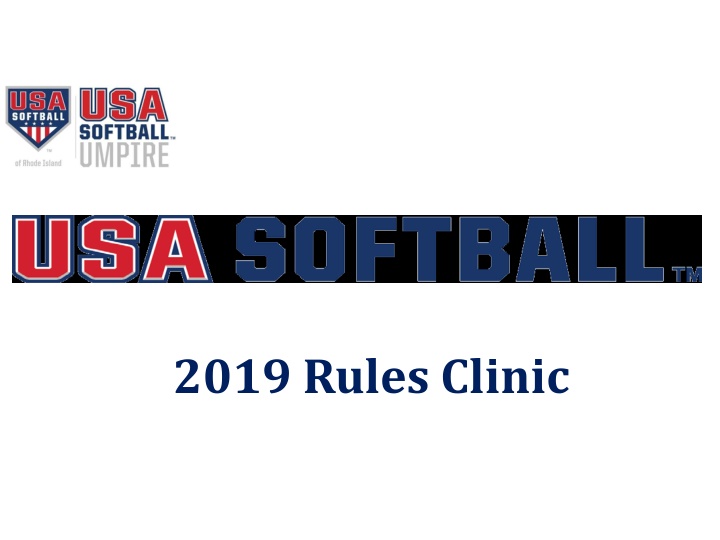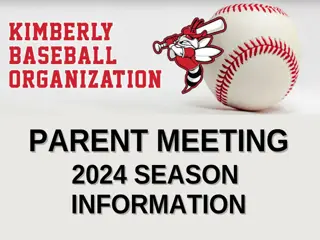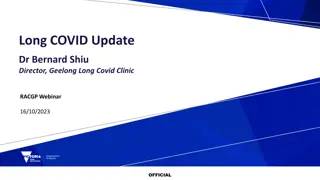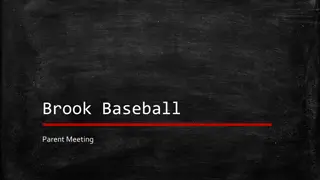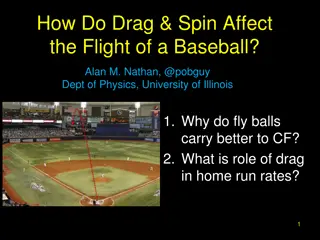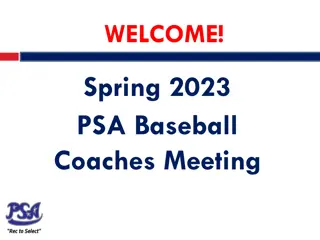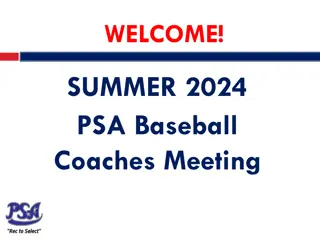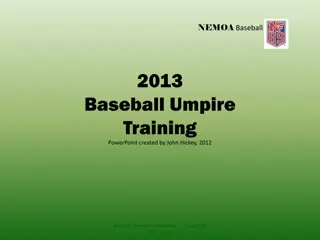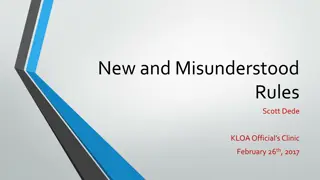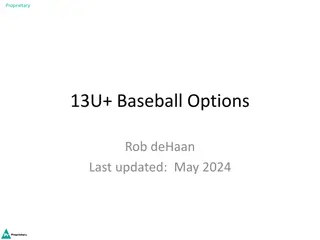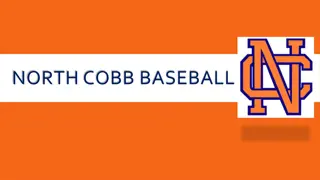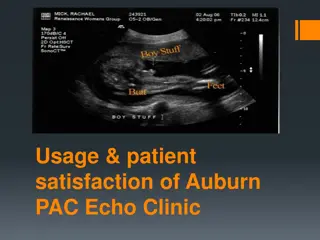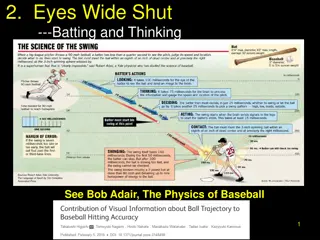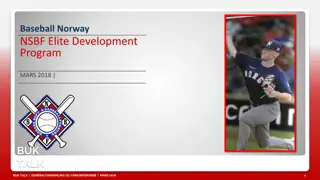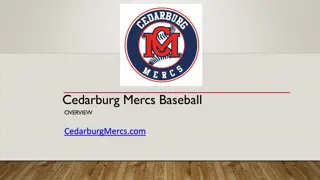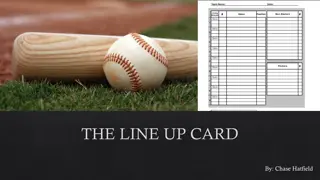Baseball Rules Clinic 2019: Key Scenarios Explained
Explore key baseball scenarios from the 2019 rules clinic, including obstruction between bases, acts that can be appealed, consequences of physical assistance by coaches, and rulings on foul ball contacts. Test your knowledge of baseball rules with these detailed explanations and images.
Download Presentation

Please find below an Image/Link to download the presentation.
The content on the website is provided AS IS for your information and personal use only. It may not be sold, licensed, or shared on other websites without obtaining consent from the author.If you encounter any issues during the download, it is possible that the publisher has removed the file from their server.
You are allowed to download the files provided on this website for personal or commercial use, subject to the condition that they are used lawfully. All files are the property of their respective owners.
The content on the website is provided AS IS for your information and personal use only. It may not be sold, licensed, or shared on other websites without obtaining consent from the author.
E N D
Presentation Transcript
1) R1 is obstructed between 1B and 2B. Even though R1 was obstructed there are reasons why they can still be called out between these two bases. Which of the following is NOT a reason they could be called out between 1B and 2B? a. If they commit an act of interference. b. Violating the look back rule. c. Missing first base, if properly appealed. d. Leaving first base early on a caught fly ball, if properly appealed.
1) Rule 8, Section 5B Effect 1 Exception b. Violating the look back rule.s
2) Which of the following is an act that cannot be appealed? a. A batter batting out of order. b. A runner missing a base. c. A batter swinging at a pitch, that the plate umpire rules a ball. d. A runner leaving a base early on a caught fly ball.
2) Rule 7, Section 2C Note, Rule8, Section 7F, Rule 8, Section 7G Effect c. A batter swinging at a pitch, that the plate umpire rules a ball.
3) When a coach physically assists a runner which of the following is a true statement? a. A dead ball is called. b. A delayed dead ball is called. c. Interference is called and all runners must return to the last base touched prior to the interference. d. The assisted runner is declared out and play continues.
3) Rule 8, Section 7E Effect d. The assisted runner is declared out and play continues.
4) F3 who is standing on the 1B foul line is contacted by B1, who is completely in the three foot running lane, while attempting to catch a fly ball in foul territory. F3 first contacts the ball in foul territory but is unable to make the catch and the ball rolls fair where F3 picks it up. The umpire should rule: a. The ball was first touched in foul territory, this is just a foul ball. b. F3 gained control of the ball in fair territory, this is ruled a fair ball. c. B1 is guilty of interference with F3, the ball is dead and B1 is called out. d. B1 was in the running lane when the contact occurred, F3 is guilty of obstruction and B1 should be awarded 2B.
4) Rule 8, Section 2F [1] c. B1 is guilty of interference with F3, the ball is dead and B1 is called out.
5) Bottom of the 7th inning, score is tied with 1 out and R1 is on 3B, R2 is on 2B and R3 is on 1B. B5 hits a fly ball over F9 s head scoring R1 from 3B. Thinking the game is over, R2 and R3 do not advance and touch their respective bases and B5 does not touch 1B. Instead they join in celebrating with team members at home plate. F1 standing near the pitching plate makes a verbal appeal to the base umpire that B5 did not touch 1B and the base umpire calls B5 out. Then F4 appeals that R3 did not touch 2B and the base umpire calls R3 out. The correct ruling is: a. This is a proper Dead Ball Appeal - Run does not count continue to the 8th inning. b. Improper Live Ball Appeal Run counts, game is over. c. Proper Dead Ball Appeal, B5 and R3 would both be out on appeal. However, when B5 was ruled out on appeal for the second out it removed the force out on R3 and since R1 had scored prior to the appeal on R3 at 2B the run would count and the game is over. d. Improper Dead Ball Appeal- No appeal can be honored after the winning run has scored.
5) Rule 5, Section 5B [1] c. Proper Dead Ball Appeal, B5 and R3 would both be out on appeal. However, when B5 was ruled out on appeal for the second out it removed the force out on R3 and since R1 had scored prior to the appeal on R3 at 2B the run would count and the game is over.
6) Prior to the pitch a batters feet may be: a.Completely within the lines of the batter s box. b.Touching the lines of the batter s box, but no part of the foot may be outside the lines. c. Touching the ground outside the batter s box as long as part of the foot is still in contact with the batter s box lines. d. Both a. and b. are correct.
6) Rule 7, Section 3A d. Both a. and b. are correct.
7) With no outs and R1 on 2B, B2 swings at and misses the pitch. R1 breaks for 3B and while F2 is throwing to 3B in an attempt to retire R1. B2, while remaining in the batter s box backs up to readjust their footing and bumps F2 causing an errant throw. What is the correct ruling? a. B2 is guilty of interference. Signal delayed dead ball and when the play is over, B2 is out and R1 must return to 2B. b. B2 is not guilty of interference as they remained in the batter s box which is a sanctuary for the batter. c. B2 is guilty of interference. The ball is dead, B2 is out and R1 must return to 2B. d.B2 is not guilty of interference because B2 s action was not intentional.
7) Rule 7 Section 6S Effect c. B2 is guilty of interference. The ball is dead, B2 is out and R1 must return to 2B.
8) With no outs, R1 at 3B and R2 at 2B, B3 hits a long shot to the outfield fence. By the time F8 retrieves the ball R1 and R2 have scored. B3 is rounding 3B and coming home when B4, the on-deck batter, is instructing B3 to slide into the plate. While doing so, B4 is hit with the thrown ball deflecting it away from F2 and in the umpires judgment removes F2 s opportunity to put B3 out. a. B4 is guilty of on-deck batter interference and B3 is declared out. b. B4 is guilty of on-deck batter interference and both B3 and B4 are declared out. c. B4 is guilty of on-deck batter interference and B4 is declared out. d. There is no interference as B4 has the right to leave the on-deck circle to direct runners advancing from third to home.
8) Rule 7, Section 1D Effect a. B4 is guilty of on-deck batter interference and B3 is declared out.
9) R1 on 3B with two outs. B4 hits a slow ground ball to F3. R1, on the play, crosses home plate as F3 fields the ball and steps toward B4 to attempt a tag. B4 stops and then steps back to avoid the tag. a. The ball is dead and B4 is out, however the run scores since R1 had touched home plate before the out occurred. b. The ball remains live, there is no out, and the run scores. c. The ball is dead, B4 is out and the run does not score. d. None of the above.
9) Rule 8, Section 2H Effect, Rule 5 Section 5B [1] c. The ball is dead, B4 is out and the run does not score.
10) With no outs and no runners on base, B1 swings and misses the pitch for strike three. The pitch hits F2 s glove and ricochets down the front of the F2 s chest protector. B1 takes off running toward 1B and then continues to 2B before F2 finally retrieves the ball before it touches the ground. a.B1 s advance is legal and they are able to remain at 2B. b. B1 is out on the catch by F2. c. Securing possession by F2 is not considered a catch as it did not go sharply and directly to the catcher s glove. d. B1 cannot advance as the ball became dead when it hit the catcher s chest protector.
10) Rule 1, Catch/No Catch A, Rule 1, Foul Tip, Rule 8, Section 4G b. B1 is out on the catch by F2.
11) R1 on 1B with no outs. B2 hits a ball that is deflected by F1; the ball changes direction towards R1 who is running to 2B. F4 who is attempting to make a play on the ball makes contact with R1. What is the proper ruling? a. This is interference by R1, the ball is dead and R1 is called out. b. If the umpire judges that F4 could have made a play on the ball, interference should be ruled, the ball is dead and R1 is called out. c. If the umpire judges that R1 intentionally interfered with F4, then interference should be ruled, the ball is dead and R1 is called out. If R1 did not intentionally interfere, then there is no violation and the ball remains live. d. If the umpire judges that F4 could have made an out, interference should be ruled, the ball is dead and R1 is called out.
11) Rule 8, Section 7J [4] c. If the umpire judges that R1 intentionally interfered with F4, then interference should be ruled, the ball is dead and R1 is called out. If R1 did not intentionally interfere, then there is no violation and the ball remains live.
12) A line drive to the outfield that hits the foul pole above the top of the fence is a: a. Four base award. b. Two base award. c. Foul ball. d. Home run.
12) Rule 1, FAIR BALL, H, Rule 8, Section 5H d. Home run.
13) With R1 on 2B and R2 on 1B, B3 hits a line drive over F4 s head. F4 throws their detached glove and hits the ball causing it to fall to the ground. What is the correct ruling? a. Rule Dead ball, award all runners two bases. b. Signal a delayed dead ball, at the end of the playing action if they have not already obtained them, award B3 3B and R1 and R2 are awarded home. c. Rule a dead ball, advance all runners 3 bases from the time of the pitch. d. Signal a delayed dead ball, at the end of the playing action eject F4 for unsporting behavior
13) Rule 8, Section 5F, Effect 1 b. Signal a delayed dead ball, at the end of the playing action if they have not already obtained them, award B3 3B and R1 and R2 are awarded home.
14) Which of the following is true about a legally batted ball that hits home plate: a. If it bounces up and hits the batter while still in the batter s box it is a foul ball. b. If it settles on home plate, it is a fair ball. c. If it is kicked by the batter-runner in fair territory when running to 1B it is interference. d. All of the above are true.
14) Rule 7, Section 4J Effect; Rule 1 Fair Ball A; Rule 8, Section 2F [4] d. All of the above are true.
15) D. Jones is replaced in the 2nd inning by T. Johnson to play defense for F7 and batting 6th. In the 3rd inning B6, T. Johnson gets a hit and D. Jones re-enters to run for T. Johnson. In the 5th inning the offense tries to re-enter T. Johnson for D. Jones and the umpires do not allow it. What is the correct ruling? a. Correct ruling, our rules states a player may only be replaced or substituted for once. b. Correct ruling, only starters can re-enter the game. c. Incorrect ruling, all players can re-enter the game once. d. None of the above
15) Rule 4, Section 5 c. Incorrect ruling, all players can re-enter the game once.
16) B1 comes to the plate and strikes out. B3 then comes up to bat and strikes out. Now B2 comes to the plate and hits a double. The defense then properly appeals before the next pitch that B2 is batting out of order. The umpire should rule: a.B2 should have batted after B1; B3 s at bat is ignored. B2 remains on 2B with 1 out and B3 comes up to bat. b.Once a pitch was thrown to B2 it made B3 s at bat legal, so the proper batter would be B4. Since B2 completed a turn at bat B4, the person who should have batted, is called out for the third out of the inning, B5 would lead off the next inning. c. Once a pitch was thrown to B2 it made them the legal batter so there is no violation, B2 remains at 2B with 2 outs and B3 is the next batter. d. Once a pitch was thrown to B2 it made them the legal batter so there is no violation, B2 remains at 2B with 2 outs and since B3 has already batted, B4 is the next batter.
16) Rule 7, Section 2D [2] Effect b.Once a pitch was thrown to B2 it made B3 s at bat legal, so the proper batter would be B4. Since B2 completed a turn at bat B4, the person who should have batted, is called out for the third out of the inning, B5 would lead off the next inning.
17) B1 hits a ground ball to the right of F3 who dives and fields the ground ball. F4 is moving to their left and continues to 1B. F3, with the ball in their glove attempts to beat B1 to 1B. F3, realizing that F4 is between them and 1B with the ball in their glove touches the glove of F4 who is standing on 1B before B1 reaches 1B. What is the correct ruling? a.When F3 and F4 s gloves touch it is the same as F3 touching the base, B1 would be out. b. In the umpires judgement F3 would have beaten B1 to the base if F4 would not have been in the way, B1 would be out. c. F3 was in control of the ball but not touching 1B and F4 was touching 1B but was not in control of the ball, B1 would be safe. d. None of the above.
17) Rule 8, Section 7C; Rule1- Fair Ball, Tag A c. F3 was in control of the ball but not touching 1B and F4 was touching 1B but was not in control of the ball, B1 would be safe.
18) In the bottom of the 3rd inning, a player runs out of the dugout to the pitcher s position and in Fast Pitch throws 5 warm up pitches, or in Slow Pitch throws 3 warm up pitches. They return to the dugout and the pitcher of record then comes out and without taking any warmup pitches, starts the bottom half of the inning. What is the correct ruling? a. Illegal it has to be the pitcher of record to throw warm up pitches. The first batter is awarded 1B in both cases. b. Legal, there is no limitation on who throws the warm up pitches. c. Legal, but if the player throwing the pitches is not in the game they are considered an unreported substitute and subject to that penalty if appealed. d. Legal, but if the player throwing the pitch is in the game they become the pitcher of record and have to face the first batter (at least one pitch).
18) Rule 6A, Section 9 & Rule 6C, Section 8 b. Legal, there is no limitation on who throws the warm up pitches.
19) The game is tied following 7 innings of play. Who is the proper player to place on 2B? a. The player who recorded the last out for the offensive team. b. The player who is scheduled to bat last in that half inning. c. A courtesy runner may be used for the player who is to be placed on 2B, as long as all courtesy runner rules are followed. d. Both b and c are correct.
19) Rule 5, Section 11 d. Both b and c are correct.
20) The batter is out when they make contact with the ball and any part of their foot is: a. In contact with the plate, even if part of the foot is still in contact with the batter s box line. b. If their entire foot is in contact with the ground completely outside the batter s box. c. If any part of the foot is in contact with the ground completely outside the batter s box, even if part of the foot is on the batter s box line. d. Both a and b are correct.
20) Rule 7, Section 6F; Rule 7 , Section 6G d. Both a and b are correct.
21) Which of the following are true about the knob of the bat: a. It shall have a diameter of at least 1.6 inches. b. It cannot have any sharp edges. c. It must be permanently attached to the bat and may be covered with grip tape. d. All of the above are true.
21 Rule 3, Section 1B d. All of the above are true.
22) With R1 still standing on 2B F2 attempting to return the pitched ball to F1 hits B2 on the arm with the ball by accident. R1 advances to 3B as the ball rolls away and is retrieved by F2. What is the proper ruling? a. B2 is out for interference and R1 must return to 2B. b. The advance of R1 to 3B is legal and B2 is not out because of the errant throw by F2. c. The ball is dead and the advancement of R1 shall be nullified. d. B2 is awarded 1B and R1 is entitled to remain at 3B.
22) Rile 7, Section 6U Effect, Exception c. The ball is dead and the advancement of R1 shall be nullified.
23) With R1 on 2B, B2 singles rounds 1B and is obstructed by F3. R1 advances to and rounds 3B. F6 receives the ball from F8 as B2 returns to 1B. F6 throws to F5 making a play on R1 at 3B. B2 seeing the throw to 3B leaves 1B advancing to 2B and is thrown out sliding into 2B. What is the correct ruling? a. B2 was obstructed between 1B and 2B they cannot be put out between those bases, B2 would be returned to 1B since that is the base the umpire judged they would have reached without the obstruction. b. B2 had obtained the base they would have reached, and there was a subsequent play on a different runner, B2 would remain out at 2B. c. Obstruction has a minimum one base advancement; therefore B2 would be awarded 2B. d. R1 being off of 3B and drawing a throw is considered interference, R1 is called out and B2 would be returned to 1B since the ball is dead on interference.
23) Rule 8, Section 5B [1], Exception a b. B2 had obtained the base they would have reached, and there was a subsequent play on a different runner, B2 would remain out at 2B.
24) F1 touches the fingers of their pitching hand to the dirt, transfers the ball to their pitching hand, and steps on the pitcher s plate. The plate umpire immediately calls an illegal pitch, announcing that F1 did not wipe their fingers after touching the dirt. What is the correct ruling? a. Illegal pitch is the correct ruling; no foreign substance may be used on the ball. b. Illegal pitch is the correct ruling, but F1 should also be ejected for using a foreign substance on the ball. c. This is an incorrect ruling; dirt is not a foreign substance and does not have to be wiped off before coming in contact with the ball. d. Illegal pitch is the correct ruling, and the umpire will issue a warning to F1 and notify their coach; if any other defensive player uses a foreign substance on the ball they will be ejected.
24) Rule 6A, Section 6A, Rule 6B, Section 6A, Rule 6C, Section 5 Rule 6D, Section 5 c. This is an incorrect ruling; dirt is not a foreign substance and does not have to be wiped off before coming in contact with the ball.
25) With 1 out and R1 on 3B and R2 on 1B, B4 hits a double scoring R1 and advancing R2 to 3B. After the ball has been returned to the infield and time is called, F7 makes a verbal appeal to the base umpire that R2 missed 2B while advancing to 3B. The correct ruling is: a. This is a proper dead ball appeal, the base umpire should rule on whether R2 missed 2B. b. Since F7 no longer has the ball, this is an improper appeal and the base umpire should not rule on the play. c. This is an improper deal ball appeal, only a coach or infielder may make a dead ball appeal. d. Since the ball is dead there is no longer an opportunity to appeal the last play
